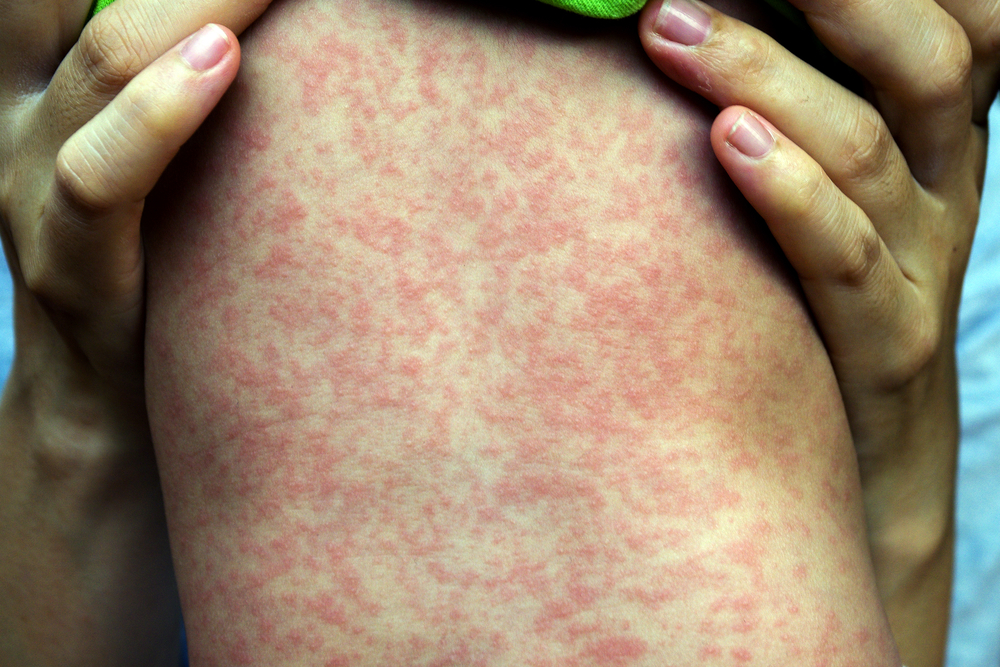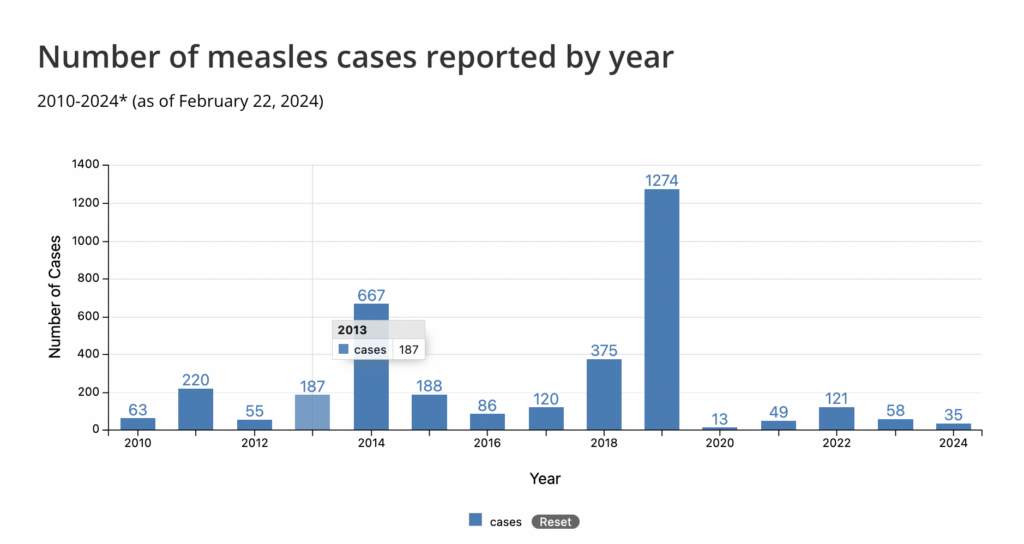What's On This Page?
ToggleThe history of measles dates back thousands of years, with evidence of the disease found in ancient writings from various cultures. Measles is caused by the measles virus, which belongs to the paramyxovirus family. The name “measles” is believed to have originated from a Dutch word “masel,” meaning “blemish” or “spot,” referring to the characteristic rash that goes hand-in-hand with measles.
Another interesting fact about measles is that it’s very specific and aimed at the human species, meaning it does not have other animal hosts, just people. This is in contrast to some other viruses, such as influenza, which can infect people and animals!
Measles, a highly contagious viral infection, has a long history of affecting populations around the world. In the old days, millions of people would get it worldwide, and there were fatalities. Reinfection can also occur, but the second time around it only causes milder upper respiratory illness – it is common in older children although some adults may manifest this. Recognizing the symptoms of measles is crucial for prompt diagnosis and proper medical care.

Much like other respiratory conditions, it is spread through respiratory droplets (containing the measles virus) are sprayed into the air as an infected person coughs or sneezes.
If someone close by then inhales or touches a surface contaminated with the virus (and then touches their eyes, nose, or mouth) they too can become infected! So it’s an airborne virus.
Not every child who comes into contact with the measles virus will necessarily get sick. I think that’s important to know upfront because I absolutely hate spreading any fear where there shouldn’t be. Fatalities are not considered the expected outcome, and it’s pretty unusual.
Vitamin D levels (even if normal) will not prevent a person from getting measles. That said, it can kick start a sluggish immune system, improving T and B cell function. Check your levels routinely, get enough sunlight and eat a healthy diet. You can learn about the 20 Unusual Signs of Vitamin D Deficiency in my article.
Measles Statistics
In 2023, the United States saw just 58 cases. Compare that to the year 2019 when there were 1,274 reported cases, over 2000 percent more! And so far in 2024, we’ve seen about 35 cases across Arizona, California, Florida, Georgia, Maryland, Minnesota, Missouri, New Jersey, New York, Pennsylvania, and Virginia. The incidence peaks in late winter usually.

Here is where you can see the STATISTICS.
As we’ve learned from the pandemic days, a virus can very easily spread from person to person. Fortunately, there are not that many cases in the U.S. but you hear about it on the news sometimes. That’s why I am writing about it. I thought it best to inform my readers about the symptoms so that they can recognize it right away.
The Signs and Symptoms of Measles
Symptoms of measles typically appear approximately a week after exposure to the virus. It may look like a typical cold or flu at first. Because parents often dismiss a little sinus congestion or runny nose in their kids, the virus (which is highly contagious) will quickly spread as their child continues to attend school and go to their outings.
One more thing, the measles virus disseminates quickly, it doesn’t stay in the respiratory tract. It quickly multiplies in exponential numbers infecting the person’s lymphatic, intestinal, skin cells, and urinary system… and sometimes the brain. Let’s go through the most common symptoms right now:
1. Fever: This can be a very high fever reaching 104°F (40°C) or higher.
2. Runny nose: A runny or stuffy nose is common so you may mistake it for a cold!
3. Cough: A persistent cough may develop, often accompanied by sneezing.
4. Sore throat: Throat discomfort or soreness is another early symptom.
5. Red watery Eyes:: Also known as “pink eye” or conjunctivitis, it essentially feels like an angry, irritated eye!
6. Small white spots: Inside the mouth, you will see small white spots called “Koplik’s spots” and they’re usually on the inner lining of the cheeks.
As the illness progresses, more characteristic symptoms of measles may develop, including:
- Rash: A red or reddish-brown rash typically appears 3, 4 or even 5 days after the initial symptoms of fever and sore throat. It starts on the face and spreads downward to the rest of your body.
- High fever: The fever associated with measles can remain high throughout the duration of the illness.
- Malaise: That’s the word clinicians use to describe sheer exhaustion! It just means you have general discomfort, fatigue, and weakness… you want to lie down all day!
- Loss of appetite: Like any illness, you don’t feel much like eating.
Not everyone with measles gets to experience all of these symptoms (luckily!) and the severity can also vary widely. For that matter, some people exposed to the virus may not even come down with measles! In other words, it’s transmissible but not every single person gets sick.

Additionally, complications over a few months may include a middle earache, pneumonia, or in rare cases, encephalitis. It doesn’t happen with every person.
You see a higher risk for complications with immunocompromised young children, pregnant women, and those with immunity-related comorbid conditions (ie cancer, HIV, Hodgkins, people supported on chemo, and so forth).
You may be interested in my other article entitled, The Link Between Chronic Fatigue and Viral Infections Plus 18 Solutions.
Early recognition and treatment of measles can help prevent complications and promote a speedy recovery so as soon as you see white spots in the mouth, or develop a high fever or a rash, call a Primary Care doctor, Family Physician or Pediatrician. It wouldn’t hurt to make some IMMUNE CUBES if you have an ice cube tray!
Some individuals may have natural immunity to measles due to previous infection as a child, or because they received the MMR vaccination, or maybe they just have an active robust immune system… either way, they may be able to fight off the virus without even realizing they had it!
PCR Tests and Diagnosis
In a 2019 article published in the Journal of Clinical Microbiology, researchers dive into diagnostics a bit more. To identify measles, doctors rely on a lab test called real-time PCR, which confirms the virus’s presence in patient samples. But here’s the tricky part: there are 2 types of measles virus – the natural virus and the weakened virus used in vaccines. Both types of measles can spark similar symptoms, but knowing which one is crucial for stopping its spread.
So, researchers came up with a new lab test called multiplex real-time reverse transcription-PCR (rtRT-PCR). This test not only detects measles virus but also tells apart the vaccine strains from the wild-type virus. It’s fast, easy to use, and can handle a bunch of patient samples at once.
The researchers found that this NEW BLOOD TEST is really good at its job – it’s sensitive, accurate, and reliable compared to other tests. It’s been a few years since that publication and I’m pretty sure QUEST offers this “real time test, however call your local lab to be sure if you want it. And probably many hospitals offer it too. Doctors can now track down and manage cases better. Plus, it’s a step forward in keeping tabs on different measles strains that circulating around the globe.
In closing, it’s a good idea to remind readers that if your child is sick with any kind of transmissible illness, keep them at home. And as adults, the same! In other words, if they are coughing, sneezing or dripping, don’t send them out, or to school. It’s such a simple thing but it can prevent outbreaks and misery for all involved.
The problem is that you (or your child) are contagious for a week or so before the rash even shows up on the skin. It’s during the phase that looks just like a “cold” when the measles virus is in the individual’s respiratory fluid. So when they sneeze or cough, they are potentially infecting everyone around them.
Finally, please don’t try to self-treat a serious illness, especially if the fever is sustained and very high like 103 and above! Using these common sense tips, I believe that fewer infections will occur.

Suzy Cohen, has been a licensed pharmacist for over 30 years and believes the best approach to chronic illness is a combination of natural medicine and conventional. She founded her own dietary supplement company specializing in custom-formulas, some of which have patents. With a special focus on functional medicine, thyroid health and drug nutrient depletion, Suzy is the author of several related books including Thyroid Healthy, Drug Muggers, Diabetes Without Drugs, and a nationally syndicated column.


